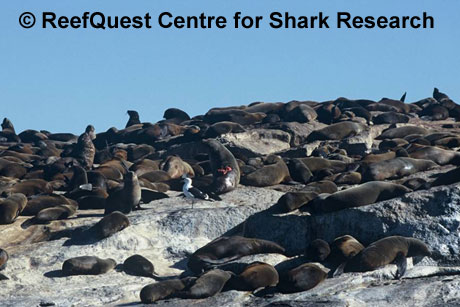Rocky Reefs:
Rich Feeding in Cool Waters
At first glance, it’s something of a mystery why temperate rocky reefs are so crowded with life. True, cool temperate waters are often very rich in nutrients, able — in theory — to support rich marine ecosystems. But rocky reef plant life and other sessile organisms are typically limited to encrusting forms and the rock faces themselves are generally flat, lacking caves, crevices, and other hidey-holes that would make them attractive as shelter. Yet rocky reefs boast a tremendous abundance and diversity of life. Why?

Cape Fur Seals (Arctocephalus pusillus pusillus) resting on Seal
Island,
South Africa, a rocky outcropping surrounded by reefs in the middle of False
Bay.
Recent studies suggest a partial explanation for the unexpected biological richness of rocky reefs. Apparently, the constant disturbance by physical factors — such as wave action and sedimentation — and the activities of large, grazing predators — particularly sea urchins — creates intermittent barren patches. This ‘free space’ is continually recolonized by the larvae or juveniles of nearby adults or by the spread of local colonial animals. Competition for limited space among these recolonizers is fierce, resulting in a rich mosaic of different species. Many of these species are at various stages of their life histories, each with different needs. The result is an incredibly dynamic ecosystem, with a high turnover of unsuccessful competitors. These unsuccessful competitors provide a rich food source for predators, which — in turn — attract ever-larger predators, including sharks.
